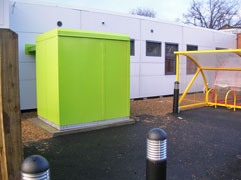Heat Pump – Ground Source Heating
A Heat Pump is a machine working on the Carnot cycle which transfers heat from a heat source to a heat sink using a vapour compression cycle. A refrigerator uses a heat pump to move heat out of a fridge. A domestic heat pump can be used to move heat from an external source into a building. Heat may be obtained from an air source, a ground source or a water source. A heat pump can concentrate such "low grade heat" into higher grade heat that can be used for space heating and domestic hot water.
Advantages of Heat Pumps
Heat pumps save money. Heat pumps are cheaper to run than direct electric heating. They are cheaper to run than oil boilers and can be cheaper than running gas boilers. Because heat pumps can be fully automated they demand much less work than biomass boilers.
Heat pumps save carbon emissions. Unlike burning oil, gas, LPG or biomass, a heat pump produces no carbon emissions on site (and no carbon emissions at all, if a renewable source of electricity is used to power them).
Heat pumps save space. There are no fuel storage requirements.
Heat pumps are safe. There is no combustion involved and no emission of potentially dangerous gases. No flues are required.
Heat pumps require less maintenance than combustion based heating systems.
Heat pumps last longer than combustion based heating systems: the most expensive part of a ground source heat pump installation, the ground loop, lasts over 100 years.
Heat pumps can provide cooling in summer, as well as heating in winter.
Heat pump installations attract up-front grants.
Heat pump systems can be installed with a 0% vat cost.
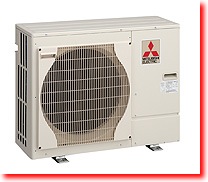
Air Source Heat Pump – ASHP
Air source heat pumps work on the same principle as roof top air conditioners – but in reverse. Many roof-top air-conditioners are reversible, and can provide heating as well as cooling, but they are usually optimised for cooling. Air source heat pumps designed for heating are often more efficient.
The fans in Air Source Heat pumps operating from air-to-air do generate noise as well as heat, so they need to be carefully sited.
Air source heat pumps are simpler and cheaper to install than a ground source heat pump. However, the outside air is coldest when you most need heat in the building so an air source heat pump will never be as efficient as a heat pump working with a well designed ground loop.
The key advantage of an Air Source Heat Pump is that it is cheaper to install than a Ground Source Heat Pump, as it needs no ground loop.
Ground Source Heat Pump – GSHP
A ground source heat pump extracts heat from the ground – whose temperature will be warmer than the air in winter (and cooler than the air in summer). For this reason they are more efficient than air source heat pumps, especially in the coldest weather when they are most needed. They generate very little noise and should last for many years with minimal servicing. See How ground source heat pumps work.
The most practical way of extracting this energy is through water circulating through pipes in the ground via a "ground heat exchanger". The pipes for the ground loop are usually laid in horizontal trenches at two metres depth, but vertical boreholes are an alternative, if more expensive, way of achieving similar results where there is not enough land to lay pipes horizontally.
At depths below six metres, the ground temperature does not vary much from the Mean Annual Air Temperature (around 9°C -11°C in the UK depending on location). At a depth below two metres, there is a large store of warmth that can be tapped for heating in the winter. However, this temperature will drop quickly where a heat pump is extracting a lot of heat from a small ground loop – it is therefore very important that the size of the ground loop matches the heating load of the building. The key to achieving this balance is a full thermal modelling exercise (see below).
A GSHP is sometimes confusingly referred to as “geothermal heat pump”, however, the heat in the ground originates from the sun (unless the borehole extends beyond 500 metres deep). True geothermal heat is found in Iceland and some other parts of the world where volcanic activity comes close to the surface of the earth.
Ground Source Heating and Cooling – GSHC
GSHC systems take advantage of the Thermal Energy Storage capacity of the ground to heat buildings in winter and cool buildings in summer. They employ "reverse cycle ground source heat pumps" to provide Renewable Heating in winter and Renewable Cooling in summer: Joined-Up Heating and Cooling.
An "unassisted" ground source heat pump may "Lock Up"
An "unassisted" GSHP is a heat pump which extracts heat from a ground loop without any mechanism for replacing the heat extracted from the ground. There is a risk that the ground temperature will fall year-by-year and that the cost of extracting heat will rise year-by-year. If the GSHP tries to extract too much heat from ground that is too cold the heat pump will "Lock Up": the control mechanism within the pump will turn it off. This risk is easily avoided by using Interseasonal Heat Transfer.

Solar Assisted Ground Source Heat Pump – SAGSHP
A solar assisted GSHP is a heat pump which not only extracts heat from a ground loop but also uses a solar thermal collecting mechanism for replacing the heat extracted from the ground. This not only avoids the risk that the ground temperature will fall year-by-year and that the cost of extracting heat will rise year-by-year, but also substantially improves the efficiency of the ground source heat pump by using the ground loop to store summer energy for use in winter.
Dual Source Heat Pump – DSHP
Because the underlying mechanism for a heat pump is the same, whether the heat source is air or water, there are circumstances where it can be advantageous for a heat pump to have access to both a ground source and an air source. A Dual Source Heat Pump provides more flexibility (to switch between heat sources during the day as the air temperature fluctuates), but requires a more sophisticated control mechanism to asses when advantage can be gained from switching between sources to achieve optimum results.
Triple Source Heat Pump – TSHP
Because the underlying mechanism for a heat pump is the same, whether the heat source is air or water, there are circumstances where it can be advantageous for a heat pump to have access to both a ground source and an air source. Additional flexibility can be available if there is a third heat source on hand, such as heat from solar thermal panels. A Triple Source Heat Pump provides more flexibility (to switch between heat sources during the day as the air temperature fluctuates), but requires a more sophisticated control mechanism to asses when advantage can be gained from switching between three heat sources to achieve optimum results. The control mechanism has to know the limits of the heat pump's capabilities in order to work within its capacity, and to know the temperature available from each heat source at any moment in order to make the optimum choice.

Water Source Heat Pump – WSHP – Open Loop Systems
Pumping river water, or water from a lake, through a heat pump may be another option. This can provide a more constant input temperature than an air source and avoids the problems that can come from lowering the temperature of a limited size ground loop. However, with an open loop system it is not possible to create a heat store to balance the heat demands between summer and winter.
Whilst delivering high-efficiency, this system may operate less well deep into winter during lower temperatures when heating is most needed, so a back-up heat source may be needed. See Dual Source Heat Pump (above).
Permission should be sought from the relevant authorities as an abstraction license may be needed for an open loop system.
Because oxygen and contamination from open loop water systems may cause pump failure, reduced efficiency or other maintenance issues through corrosion or limescale, it may be preferable to use a closed loop system with a heat exchanger in the water source.
See also: Water Source Heat Pumps.
See also DECC's Water Source Heat Map which identifies potential sites for large scale district heat sharing to provide renewable heating and renewable cooling.
Water Source heat pumps may be further divided into Surface Water Source Heat Pumps and Groundwater Heat Pumps, which heat exchange with groundwater from an aquifer and return the groundwater by another well into the aquifer.
Marine Source Heat Pump – MSHP – Open Loop Systems
It is also possible to heat exchange with water from the open sea for large properties by the sea: Marine Source Heat Pumps.
How is heat best delivered into the building?
Heat pumps usually deliver heat in the form of hot water, like most conventional central heating systems. However, to maintain a high energy efficiency, the distribution system should be designed so that the water temperature is as low as possible. A well-designed underfloor heating system can be designed to distribute fluid at 40°C. If radiator heat distribution is the only practical alternative in a refurbishment, then they will need to be larger than in a conventional radiator system where the water is distributed at 75°C. Ducted hot air is an alternative method of distributing heat into a building, however, this is often not as comfortable as radiant underfloor heating and is only appropriate in a well insulated building.
Heat Pump Output Temperature
While the heat pump output depends on the capacity and efficiency of the heat pump itself, it also depends greatly on the conditions under which it is operating. The key factors are the temperature of the heat source and the temperature of the heat sink. An air source heat pump with an external temperature of -15°C will struggle to produce an output of 60°C to heat water with any efficiency. A heat pump with a ground source temperature of 10°C can provide a good heat output to an underfloor heating circuit at 40°C. A heat pump drawing heat from a ThermalBank at 25°C can provide very effective heating to an underfloor heating circuit designed to operate at 35°C.
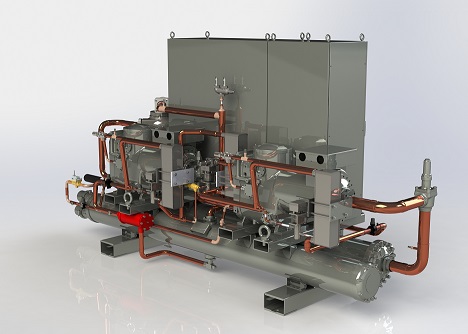
High Temperature Heat Pumps
The CoP of a heat pump will generally improve the lower the output temperature delivered: therefore the designer aims for a well designed heat emitter system such as underfloor heating where 35°C is sufficient to provide comfortable temperatures. However, if a heat pump is to be used in an existing building with limited heat emitters for the heat load, such as undersized radiators, then it will be appropriate to specify a high temperature heat pump to avoid the disruption that would be caused by refurbishing the heat emitter system.
There are now heat pumps capable of delivering output temperatures of 80°C which is more that sufficient for DHW needs and to warm a building with undersized radiators. Although the CoP will fall if output temperatures are raised to 80°C, a well designed inverter-driven high temperature heat pump with a good control system, including weather compensation, will only deliver 80°C when it is required: otherwise it will modulate the heat pump to deliver lower temperatures – at a higher efficiency – when the heating load is below peak requirements.
Cooling using heat pumps
In summer, buildings can overheat, especially if they have been designed with high insulation to retain heat in winter. The main cause is solar gain from sunlight, but powerful lighting in commercial buildings, together with heat gains from people and computers, can add up to the need for cooling, even in colder months. One square metre of sunlight through a window can contribute almost one kilowatt of heat to the room. Air-to-air heat pump systems, are used throughout the world for air conditioning. Their energy consumption is high as they work on the principle of "wasting" heat to the exterior. The need for air conditioning can be reduced by good design and taking measures to reduce solar gain in summer.
If cooling is necessary, then a water or ground-coupled heat pump system can be used to reject heat to the ground.
If the liquid from the ground source is pumped directly around the underfloor heating pipes, then a certain amount of ‘free cooling’ can be achieved.
An asphalt heat rejector can also be used to purge heat from a building at night.
Earth Energy Systems – EES
A ground source heat pump uses the earth as the source of heat in the winter, and as the "sink" for heat removed from the building in the summer. For this reason, ground source heat pump systems are also known as earth-energy systems (EESs).
Coefficient of Performance – CoP
The Coefficient of Performance is found by dividing the useful heat output by the electrical energy input. A heat pump that produces 4 kilowatts of heat for 1 kilowatt of electricity has a CoP of 4.
Can I expect a CoP of 4 from a GSHP?
Not necessarily. A heat pump may yield a CoP of 4 in test conditions, but it will not always do so in an installation unless the ground loop is well designed and the heat delivery mechanism in the building is also well matched to a GSHP.
Is it true that the CoP of a GSHP degrades as time passes?
As a GSHP draws heat out of the ground, the ground temperature will fall from its natural temperature of 10°C at depth towards 0°C or colder. The heat pump must work harder to produce the same output from a lower heat input: therefore the CoP tends to fall over the heating season (unless the ground loop is large enough and heat is only extracted slowly).
Will the ground temperature recover before the next heating season starts?
Heat only moves very slowly through the ground, so the ground temperature may not have recovered fully before the next heating season starts: heat recovery will depend on many factors including the size of the ground loop, the depth of the ground loop and the conductivity of the ground. If too much heat is extracted from a low volume of ground the temperature of the ground may fall year-by-year and an unbalanced system then becomes unsustainable and uneconomic.
Seasonal Performance Factor – SPF
Seasonal Performance Factor is similar to CoP, but is an average figure taken over the heating season. The SPF will be lower than the CoP because the CoP is usually measured in (favourable) autumn conditions and the CoP will fall over the heating season as heat is extracted from the ground.
Energy Efficiency Ratio – EER
The EER is a measure of the efficiency of a heat pump in cooling mode. The rated cooling capacity is divided by the rated total power input. This is equivalent to the CoP, which is quoted when the the heat pump is in heating mode.
Heat Source and Heat Sink
Heat is extracted from a heat source (the air, the ground or ground water) and transferred to a heat sink (underfloor heating pipes or radiators in the building).
Open Loop
River or ground water is pumped through a heat pump then expelled to the environment a few degrees colder. There is a risk of contamination and damage to the heat pump from foreign matter drawn through the mechanism. An open loop system can have the advantage of accessing a constant temperature, but it looses any opportunity of being able to store heat in the ground between seasons.
Closed Loop
This is where sealed polymer ground pipes are used as the heat exchange mechanism with the ground. The fluid in the closed circuit is likely to need antifreeze. A closed loop provides an opportunity to add heat to the ground and use the ground as a thermal store.
Slinky Ground Loop
The name used for coiled ground temperature collector pipes buried in a trench in the ground.
Horizontal Collector Ground Loop
This can be either coiled 'Slinky' or straight pipes that are buried up to two metres deep in open ground. The pipe is usually plastic and contains antifreeze.
Borehole Heat Exchangers – Boreholes and Borehole Fields
A borehole is drilled vertically down into the ground into which the heat collector pipe is installed. Angled boreholes, also called inclined boreholes, can be used if surface area is limited. Drilling boreholes is expensive as heavy equipment is required, but may be a suitable option where land space is limited. A large installation will require a set of boreholes – a borehole field.
Ground Source Heat Exchangers – GSHE
A ground source heat exchanger is another name for a borehole drilled vertically down into the ground into which the heat exchange pipe is installed.
Ground Heat Exchanger – GHE
A ground heat exchanger is another name for a borehole drilled vertically down into the ground into which the heat exchange pipe is installed.
Refrigerant
The heat transfer fluid contained in a heat pump refrigeration circuit. This is a volatile fluid contained in a hermetically sealed circuit; refrigerants can be one of a number of man-made Fluorocarbons or a Hydrocarbon compound. The gas yields heat when compressed to a liquid and absorbs heat when it evaporates to a gas. The fluid is sealed in to a closed circuit and does not degrade within the life of the heat pump.
Passive Cooling
Passive cooling can take place when cooled water is pumped around the underfloor heating circuits. This gives limited amount of ‘free cooling’ but will only work with large borehole fields or large ground loops.
Geothermal Heat
Geothermal heat is ‘heat from the earth’. Proper geothermal heat can be extracted from the earth’s core only from very deep in the ground, or where volcanic activity occurs near the surface as in Iceland. The term 'Geothermal Heat Pump' is sometimes adopted for marketing reasons in place of ‘Ground source heat pump’.
Buffer Tank
A large water cylinder can be used as a buffer tank to improve the efficiency and durability of a heat pump. It reduces the number of stop/starts that the compressor makes, and ensures a high flowrate through the heat pump.
Heat Pump Rating
A heat pump is given a kilowatt rating. This value will vary depending on the working temperatures. The electrical power input will be between a 1/2 and a 1/5 of the heat output.
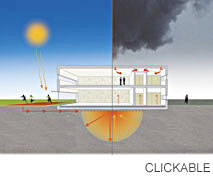
Interseasonal Heat Transfer
Interseasonal Heat Transfer is a new form of on site renewable energy from ICAX Ltd that combines the merits of solar thermal collection in summer with heat storage in ThermalBanks to double the efficiency and Coefficient of Performance of ground source heat pumps in winter.
Interseasonal Heat Transfer captures surplus heat from summer sunshine, stores it in ThermalBanks™ in the ground and releases it to heat buildings in winter.
Interseasonal Heat Transfer also captures cold on winter nights, stores this in ThermalBanks™ in the ground and releases it to cool buildings in summer.
An IHT system includes a ThermalBank to store heat energy, a heat pump and a smart control system. It also includes a mechanism for ensuring heat is added to the ThermalBank in summer: this may include an Asphalt Solar Collector, solar thermal panels or heat storage as a by product of providing cooling to the building in summer. Each building is unique so the design will depend on the building, its uses, the location and the local geology.
Intrabuilding Heat Transfer
Intrabuilding Heat Transfer is the transfer of excess heat from hot rooms within a building to cold rooms needing space heating. ICAX is able to extract heat from IT fileserver rooms and transfer it to cold rooms by using the heat transfer mechanism in the ICAX Skid in conjunction fan coil units.
Intrabuilding Heat Transfer saves energy by balancing the heating loads and cooling loads within a building. Where a building suffers an overall cooling need in summer, ICAX uses Interseasonal Heat Transfer to transfer the excess heat to a ThermalBank in the ground. Where an overall heating need exists in winter ICAX recovers the stored heat from the ThermalBank to heat the building in winter using the ICAX Skid which incorporates heat pumps.
Intrabuilding Heat Transfer from ICAX is a major step towards balancing the heating loads within a building and achieving Zero Carbon Buildings.
Energy Recycling
Energy Recycling can be a very effective form of saving money and saving carbon emissions. Interseasonal Heat Transfer performs Energy Recycling by collecting surplus heat in summer, storing it in ThermalBanks over the autumn and recycling it through ground source heat pumps back to the building in winter. You don't have to pay twice for the same thing: IHT saves heat energy when you have more than you need, and returns it to you when you have less than you need.
Underfloor Heating
Underfloor heating is an efficient method of distributing heat into a building to provide comfortable space heating (whether you use IHT or not). Lower temperatures (around 40°C) can be distributed over a larger area than the higher temperatures (around 70°C) needed for wall mounted radiators. Underfloor heating is invisible and clutter-free and radiates heat gently from ground level to avoid the convection and heat losses generated by wall mounted radiators. Underfloor heating makes a good match for distributing heat from a ground source heat pump – because a GSHP will deliver a higher coefficient of performance if a lower delivery temperature can be used.
The underfloor piping can also be used to extract heat from the building in summer by circulating cold water to provide "critical period cooling".
"Free Cooling"
"Free Cooling" is used to mean "heat dumping" from a building "source" to an external "sink" purely by means of circulating water to transport heat out of the building. "Critical period cooling" is the use of free cooling to cover brief times of high need for cooling – at a much cheaper price than full air conditioning.
The Merton Rule
The Merton Rule states that: “All new non-residential development above a threshold of 1,000 square metres will be expected to incorporate renewable energy production equipment to provide at least 10% of predicted energy requirements.”
The Merton Rule is named after Merton Council which adopted the first prescriptive planning policy that required new commercial buildings over 1,000 square metres to generate at least 10% of their energy using on site renewable energy. In 2008, the Government's Planning Policy Statement requires all UK local planning authorities to adopt a "Merton Rule" policy.
Thermal Modelling
Thermal Modelling is critical to good design in any installation of a ground source heat pump. The sizing of the ground loop is key to the successful operation of the heat pump. Before sizing the ground loop correctly it is necessary to understand the qualities of the ground to be used as well as the expected heating loads and cooling loads of the building and these will be affected by the design of the building, its orientation to the sun, the activities in the building and the ventilation strategies. These are complex issues which need to be analysed in a thermal model to ensure that the system will meet the temperatures required in the building throughout the seasons of the year in a well balanced and sustainable way.
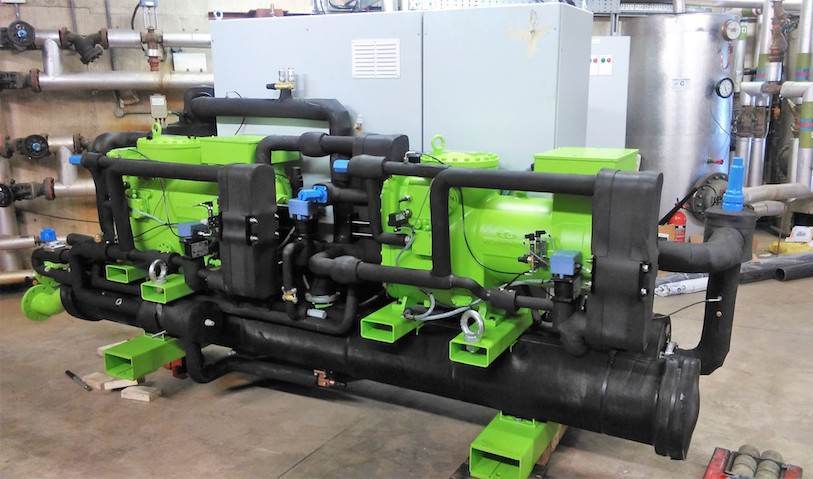
Conclusion
Ground source heat pumps work best when used in a well designed installation to balance the heating and cooling needs of a building over the seasons. A GSHP can do this by transferring heat to or from the ground it stands on to achieve a well moderated temperature in the building all year round.
Contact ICAX
We prefer to work in conjunction with architects and M&E consultants from the earliest stage to ensure that there is a clear understanding of how we can help to deliver a sustainable building with a high carbon offset.
Please email enquiries to
or give us a ring on 020 7253 2240.
Ground Source Heating Ground Source Cooling Ground Source Energy

